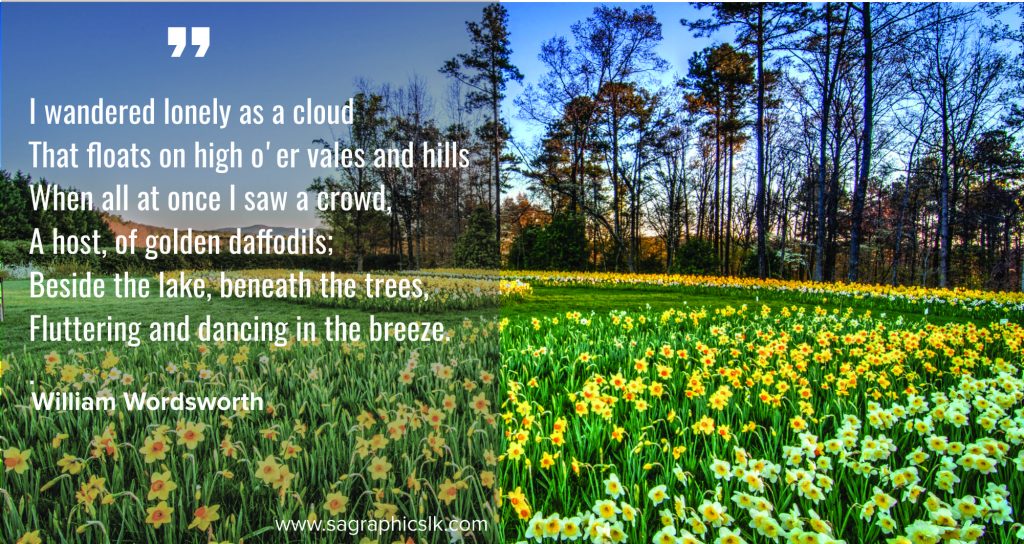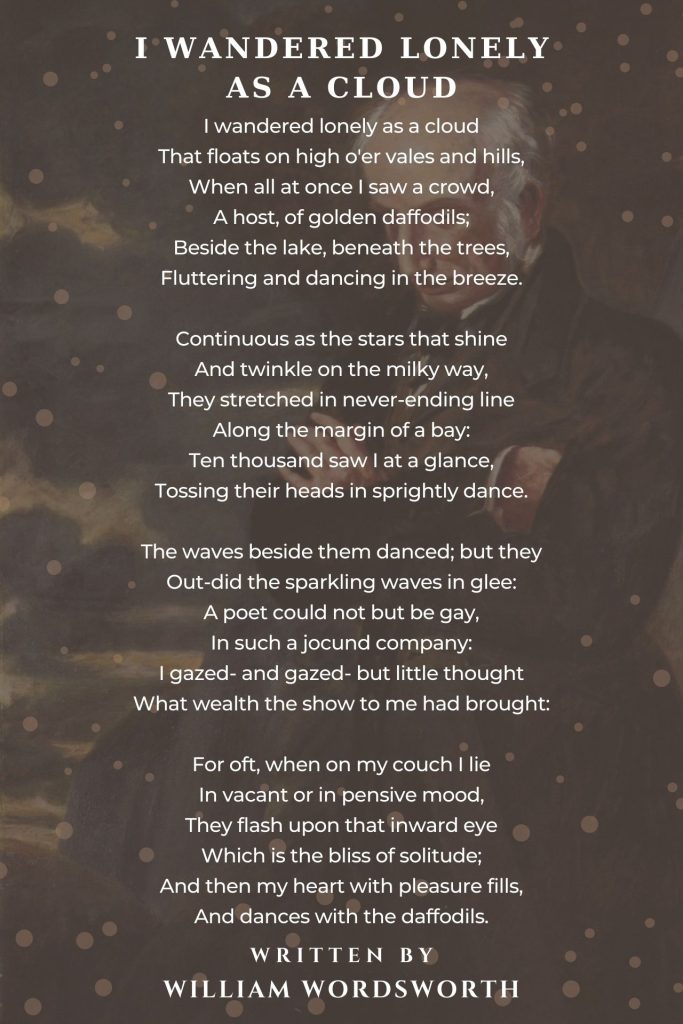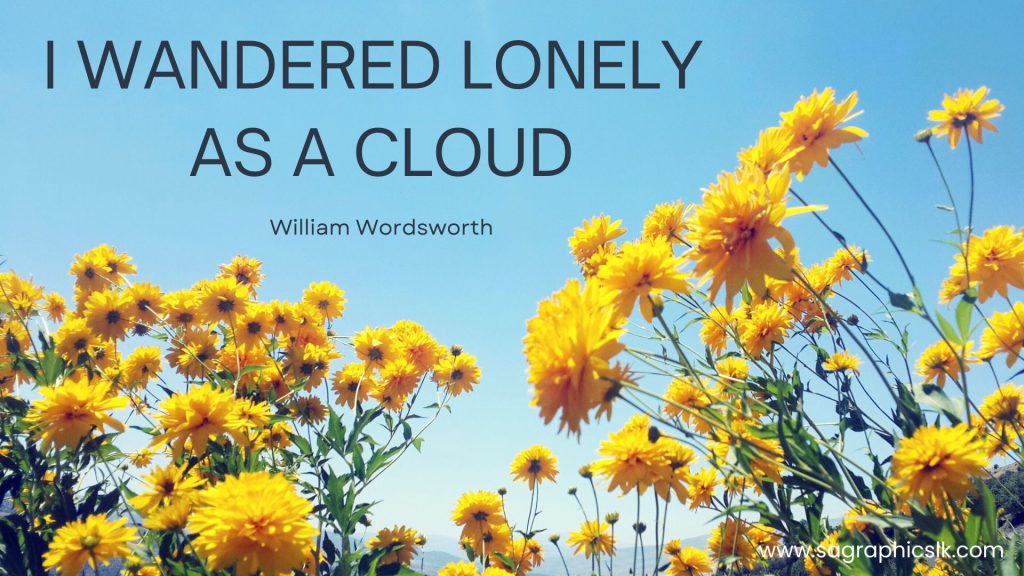I Wandered Lonely as a Cloud (also commonly known as “Daffodils”) is one of the most popular lyric poems by William Wordsworth. A classic of the Romantic Movement in the early 19th century, the poem is Wordsworth’s best-known work for its celebration of the beauty of nature and its ability to bring joy and happiness in times of despair. The speaker, likely William Wordsworth himself, is wandering down the valley when he stumbled upon a beautiful field of daffodils seemingly waving, fluttering, and dancing, a sight worth a thousand words.
“I Wandered Lonely as a Cloud” is also known for its use of imagery, particularly the image of the daffodils dancing in the breeze, which creates a sense of movement and liveliness that contrasts with the stillness and isolation. The poem makes use of personification, as the daffodils are described as “dancing” and “tossing their heads” which imbues them with human characteristics and adds to the lively and joyful nature of the scene.
William Wordsworth describes how a host of golden daffodils fluttering and dancing in the breeze of the Lake District mesmerized his heart. The poet metaphorically compares him to a cloud for describing his mental state on that day. Like a cloud, he was wandering in the valley aimlessly and the sudden spark that the daffodils gave to his creative mind is expressed in this poem.
Related Post: The 10 BEST William Wordsworth Poems

I Wandered Lonely As A Cloud (Daffodils)
William Wordsworth
I wandered lonely as a cloud
That floats on high o’er vales and hills,
When all at once I saw a crowd,
A host, of golden daffodils;
Beside the lake, beneath the trees,
Fluttering and dancing in the breeze.
Continuous as the stars that shine
And twinkle on the milky way,
They stretched in never-ending line
Along the margin of a bay:
Ten thousand saw I at a glance,
Tossing their heads in sprightly dance.
The waves beside them danced; but they
Out-did the sparkling waves in glee:
A poet could not but be gay,
In such a jocund company:
I gazed—and gazed—but little thought
What wealth the show to me had brought:
For oft, when on my couch I lie
In vacant or in pensive mood,
They flash upon that inward eye
Which is the bliss of solitude;
And then my heart with pleasure fills,
And dances with the daffodils.
Background of the Poem
At the time he wrote the poem, Wordsworth was living with his wife, Mary Hutchinson, and sister, Dorothy, at Town End, in Grasmere, in the Lake District. The inspiration for the poem came from a walk on April 15, 1802, when Wordsworth and his sister Dorothy came across a host of daffodils around Glencoyne Bay, Ullswater, in the Lake District of England. The energetic dance of daffodils helped him pen down this best-loved, sweet little piece of work. The poem was composed within the time period of 1804-1807 and subsequently published in 1807, with a revised version published in 1815.
The roots of this poem, I Wandered Lonely as a Cloud” can be traced back to Dorothy Wordsworth’s journal, in which she describes the walk with his brother in 1802, where they came across beautiful daffodils. Below is the extract.
“When we were in the woods beyond Gowbarrow park we saw a few daffodils close to
the water side, we fancied that the lake had floated the seed ashore and that the little
colony had so sprung up – But as we went along there were more and yet more and at last
under the boughs of the trees, we saw that there was a long belt of them along the shore,
about the breadth of a country turnpike road.I never saw daffodils so beautiful they grew among the mossy stones about and about them, some rested their heads upon these stones as on a pillow for weariness and the rest tossed and reeled and danced and seemed as if they verily laughed with the wind that blew upon them over the Lake, they looked so gay ever glancing ever changing. This wind blew directly over the lake to them. There was here and there a little knot and a few stragglers a few yards higher up but they were so few as not to disturb the simplicity and unity and life of that one busy highway – We rested again and again. “
— Dorothy Wordsworth, The Grasmere Journal, Thursday, 15 April 1802
Brief Analysis of “I Wandered Lonely As A Cloud“
The poem is divided into four stanzas of six lines each.
The first stanza sets the scene and describes the speaker’s feeling of loneliness as they wander down the valley and hills through the countryside. The imagery of a cloud floating over hills and valleys evokes a sense of isolation and detachment, which contrasts with the vibrant and joyful scene that the speaker is about to encounter.
The second stanza describes the moment when the speaker comes across a beautiful field of daffodils. The imagery of the daffodils stretching in a “never-ending line” along the shoreline creates a sense of awe and wonder, and the comparison to the stars in the Milky Way emphasizes the vastness and beauty of the scene.
The third stanza describes the speaker’s emotional response to the scene. The use of words like “gay” and “jocund” suggest that the sight of the daffodils has brought the speaker a sense of happiness and pleasure.
The last stanza describes the lasting effect of the daffodils. The use of the phrase “And then my heart with pleasure fills / And dances with the daffodils” suggests that the sight of the daffodils has lifted the speaker’s spirits and brought them a sense of joy and happiness.

Affiliate Disclosure: As an Amazon Associate, I earn from qualifying purchases. This blog post may contain other affiliate links as well by which I earn commissions at no extra cost to you.


Appreciating the commitment you put into your site and detailed information you provide.
It’s nice to come across a blog every once in a while that
isn’t the same old rehashed material. Great read!
I’ve bookmarked your site and I’m including your RSS feeds to my Google account.
” Appreciate your feedback. Thank you. “